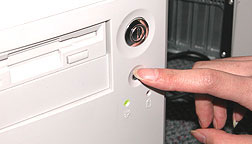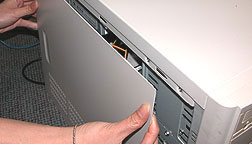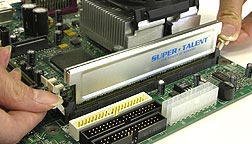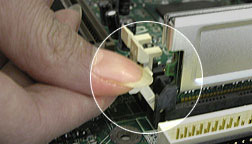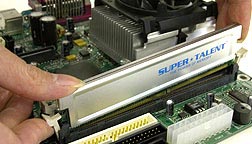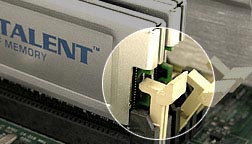1. Open your
computer.
Turn off your computer, unplug
it, and remove the cover.
2.
Locate the DIMM sockets in your computer
If there are no vacant DIMM sockets you will need to
remove an existing DIMM. You can eject the DIMM by
pressing down and outward on the retention clips.
3.
Plug in your DIMM modules
Remove your DIMM
module from its package. Line up the row of gold
pads on your DIMM with the DIMM socket, making
sure the notches on the module align with the
notches in the socket.
Here are some tips
to help you determine which DIMM socket to
use:
- Use the DIMM socket(s) with the lowest
number printed on the motherboard (eg. DIMM0
first)
- If there are no numbers visible, use
the DIMM socket(s) closest to the CPU first
-
Use the DIMM socket adjacent to an occupied DIMM
socket
- Or, consult your motherboard manual to
determine which DIMM socket(s) to
use.
Firmly press the module into the
socket with your thumbs. Make sure the retention
clips snap into the notches in the ends of the
module to hold it in place. When the module is
properly seated the retention clips on each end of
the socket should be clipped into the rounded
retention notches.
4.
Put the cover back on your computer
Screw
the cover onto your computer, plug it back in, and
enjoy your new memory!
|
*If you have any problems after
installing the memory, try these troubleshooting
steps:
- Did you plug your computer and monitor
in?
- Is your memory module properly seated in
the DIMM socket? If in doubt, eject the DIMM
module by pressing down on the two retention clips
and reinstall it, making sure the module snaps
into place firmly.
- Did you inadvertently
unplug a cable inside or outside your computer
while performing the upgrade? Check all cables and
make sure every one is properly
connected
|



